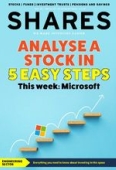Archived article
Please note that tax, investment, pension and ISA rules can change and the information and any views contained in this article may now be inaccurate.
Analyse a stock in five easy steps

Stock research is a lot like buying a car. You can base a decision solely on technical specifications, but it’s also important to consider how the ride feels on the road, the manufacturer’s reputation and whether there is enough space.
Equity investors can choose from thousands of stocks – nearly 2,000 in the UK and another 6,000 or so in the US. Australia, Canada and Europe offer even more.
There is no single way to analyse these companies; after all, banks, miners, pharmaceuticals and tech firms all have their unique characteristics. You could spend months pouring over financial reports, statistics and news relevant to each, but it doesn’t have to be this way.
In a new mini-series, Shares offers a simple framework which will help form the basis of your investment research.
ANALYSING MICROSOFT
In this opening episode, we are going to look at Microsoft (MSFT:NASDAQ), one of the world’s largest and widely-owned companies, and whose share price has been on a tear this year, up 38% since the start of January.
Hopefully, you will come away from this feature with a far deeper understanding of what has driven the software giant’s past performance, and a decent chance of sizing up whether that will continue in the future.
STEP ONE: ANALYSING SALES GROWTH
As with most growth companies, the best place to start is to look back at the company’s history of revenue expansion.
The past five years is fine, but 10 years is better as it should give you a real feel for its growth journey, information that gives you a sharp lens through which to peer into the future.
What immediately stands out is that Microsoft’s growth has accelerated in recent years, albeit slower in the 12-month period to June 2023.
We know cloud computing has been a big driver, and Microsoft has been very successful at selling its main products – the Windows operating systems, Microsoft 365 suite of productivity applications, Azure big data analytics, etc – as cloud-hosted subscriptions rather than upfront licences.
Cloud computing might seem new, but tech industry experts have been talking about it for decades. Most experts believe we are still in the early adoption phase. What’s made the difference in recent years is faster broadband and mobile connections, and advanced microchips giving us much more powerful smartphones and laptops.
That shift from licences to subscriptions temporarily impacted the way Microsoft recorded revenue, meaning growth technically slowed down for a few years during the middle of the last decade. But the switch has paid-off massively, as we can see from Microsoft’s far-faster growth since 2018.
We also know that demand for Microsoft’s cloud-based products and services exploded during the pandemic, a huge enabler of work-from-home. This slowed last year, perhaps inevitably for a business generating nearly $212 billion of annual sales.
There is now another catalyst to fire up sales. Microsoft has emerged as an AI (artificial intelligence) leader, a market looking at enormous growth over the next few years. Data from Statista estimates AI revenues across the tech sector will go from roughly $95 billion in 2021 to $1.85 trillion by 2030.
Putting all of this together, Microsoft’s average annual revenue growth of 10.7% over the past decade looks sustainable and could accelerate if the company is able to remain one of the dominant AI forces going forward.
STEP TWO: HOW PROFITABLE ARE SALES?
Next, we want to work out how profitable those sales are likely to be in the future. We do this by looking at operating profit margins, or sometimes called EBIT (earnings before interest and tax) margins.
If margins expand, then profit will grow faster than sales, while the reverse is true.
There are encouraging signs with Microsoft’s margins, with the software giant’s sales becoming increasingly profitable over time. The pattern ties in with the shift to subscriptions, further evidence that the transition was well worth the bumps along the way.
By and large, about 10 percentage points have been added to operating profit margins since 2014. To think of it a different way, the margin improvement over 10 years added roughly $23 billion of extra operating profit from last year’s $211.9 billion sales, about $88.5 billion instead of the approximate $65.7 billion had margins stayed flat.
STEP THREE: HOW MUCH PROFIT CONVERTS INTO CASH?
Microsoft will have to invest significant sums in AI to maximise returns from the technology. Capital expenditure as a percentage of sales in low double-digits (13.3% in fiscal 2023) looks unlikely to return to the high single-digits of eight years ago.
This implies free cash flow as a percentage of net income will remain depressed for the next few years. On the other hand, Microsoft’s largely subscriptions model means the company is already a very powerful free cash flow machine that has been adding extra muscle in recent years.
Free cash flow in fiscal 2021, 2022 and 2023 was reported at $41.3 billion, $49.5 billion and $52.5 billion respectively, giving Microsoft a large margin of safety for its investment plans. If Microsoft can continue to convert more of its net income into cash flow going forward, free cash flow will grow faster than net profit.
STEP FOUR: QUALITY OF MICROSOFT’S MODEL
Microsoft’s balance sheet shows the firm has around $111 billion in cash and short-term investments (shown under the assets side of the balance sheet), and roughly $60 billion in long-term debt (that’s the liabilities side).
Servicing more debt could soak up cash flow in the form of interest and capital payments but that’s clearly not an issue for Microsoft.
At this point in our analysis, we want to examine return on capital employed, or ROCE, the single most important financial metric for Fundsmith Equity’s (B41YBW7) Terry Smith. In simple terms, return on capital employed in the high teens is good, above 20% is very good.
Return on capital employed is a measure of how effectively a company invests its surplus cash to create extra value for shareholders. Microsoft’s 24.8% six-year ROCE average means that for every $1 invested, it has created $0.248 of shareholder value. What’s more, Microsoft has been getting better at investing its capital over recent years, and there is no reason to believe that an average ROCE of around 25% isn’t sustainable in the future.
STEP FIVE: VALUATION CHECK-UP
The evidence for owning Microsoft shares is compelling. The wider market largely agrees, hence why the stock has performed well over the years. A 38% year-to-date gain is impressive compared to the S&P 500’s 19% return, and it also beats the Nasdaq Composite’s 35% return.
Owning the stock has returned an average 27% a year since 2014, far better than either the Nasdaq Composite’s 15.7% or the 12.5% of the S&P 500, according to Morningstar data.
The flip side to this situation is that Microsoft’s shares are not cheap. At roughly $330, the stock trades on nearly 30 times forward earnings. But it is questionable how useful a simple one-year price to earnings (or PE) ratio really is, given that growth firms like Microsoft are expected to produce much greater cash flows and profits in the future.
One easy way to adjust the PE ratio is to look at available forecasts and take an average over a three-year period. According to Koyfin data, Microsoft is expected to post earnings per share of $11, $12.7 and $14.6 in fiscal 2024 through to 2026. This implies an average three-year PE of about 26 on mid-double-digit earnings growth.
An average three-year PE is an imperfect solution, and it also doesn’t account for Microsoft’s vast $111 billion cash pile. An alternative valuation metric used by analysts is EV/EBITDA, or enterprise value to earnings before interest, tax, depreciation and amortisation.
The traditional rule-of thumb is that an EV/EBITDA of 10 or below is attractive, while mid-teens multiples are not unusual for growth companies. Given Microsoft’s reliable subscription income streams, high profit margins and excellent cash conversion, you would expect to pay a premium.
Microsoft’s enterprise value stands at $2.35 trillion, based on its $2.46 trillion market value minus the $111 billion of net cash. This implies a one-year EV/EBITDA multiple of 20, based on the $117.8 billion consensus EBITDA for the year to June 2024.
But as with the PE ratio, the EV/EBITDA ratio doesn’t account for Microsoft’s forecast EBITDA growth, again projected in the mid-teens by analysts. Applying the same three-year average calculation would put Microsoft on a 17.5-times EV/EBITDA multiple.
ARE THE SHARES WORTH BUYING?
In short, yes. Microsoft is one of the world’s highest quality businesses with a proven value creation track record over multiple years.
Its tools are critical to almost every business and millions of consumers are tied into its ecosystem. This should secure its revenue, profit, cash flows and dividends for years to come.
It is already one of the world’s biggest players in cloud computing, which experts believe still has years of growth to run, while Microsoft is only scratching the surface in AI, and who knows what other opportunities will emerge in time.
What we do know is that Microsoft has the expertise, market positioning and the financial might to grasp any new ventures
with both hands.
DISCLAIMER: The author of this article (Steven Frazer) and the editor (Daniel Coatsworth) own shares in Fundsmith Equity.
Important information:
These articles are provided by Shares magazine which is published by AJ Bell Media, a part of AJ Bell. Shares is not written by AJ Bell.
Shares is provided for your general information and use and is not a personal recommendation to invest. It is not intended to be relied upon by you in making or not making any investment decisions. The investments referred to in these articles will not be suitable for all investors. If in doubt please seek appropriate independent financial advice.
Investors acting on the information in these articles do so at their own risk and AJ Bell Media and its staff do not accept liability for losses suffered by investors as a result of their investment decisions.
Issue contents
Feature
Great Ideas
News
- Smithson bounces back from a poor year with significant outperformance in 2023
- Domino’s Pizza shares up 42% in a month but analysts still to be won over
- The important points from Barclays, HSBC, Lloyds and NatWest results
- How Adobe rode the AI wave to gain 50% in 2023
- On The Beach’s shares are looking ill after halving in six months

 magazine
magazine








